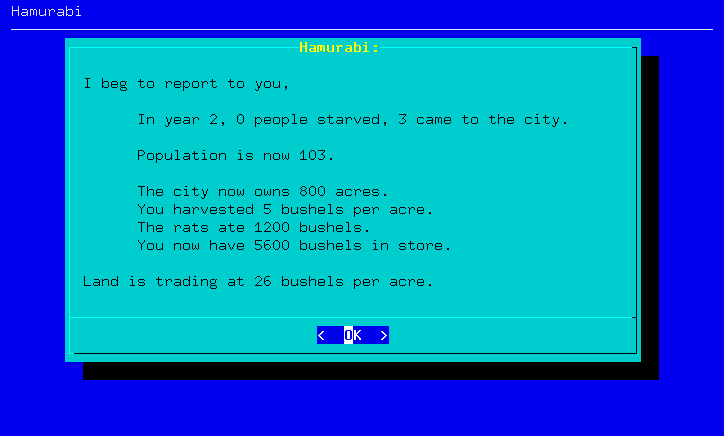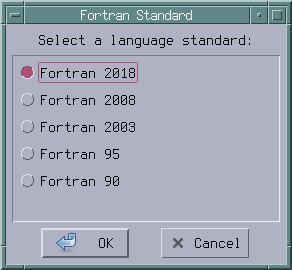Dialog
Creating text-based or graphical user interfaces does not require a full-featured toolkit, like GTK or Tk, in every case. Instead, command-line utilities may already be sufficient to display program output, or ask for user input. The dialog tool, originally written by Savio Lam in 1993 and later reimplemented by Thomas E. Dickey, is based on ncurses and supports 29 widget types (fig. 1). The project provides a C library as well. Both are available for most Unix-like environments, among them Linux, BSD, macOS, and Cygwin. Additional wrapper libraries are available for Python, Perl, and Ruby. The dialog program is usually executed from command-line or shell script:
$ dialog <common options> <widget> <widget options>The following command displays a dialog window to ask for a response:
$ dialog --yesno "Do you want to continue?" 6 32The user’s choice is returned as the program exit status.

- Fig. 1: Port of Hamurabi to Fortran, using dialog for input and output
There are alternatives to the text-based dialog:
- bsddialog
- Reimplementation of dialog and its C library.
- whiptail
- A dialog replacement using Newt instead of ncurses.
Other programs display graphical dialog windows:
- kdialog
- A Qt-based dialog tool, targeting KDE. Only partially compatible to dialog.
- tpmg
- A dialog tool much like Zenity or kdialog, written in core Tcl/Tk.
- Xdialog
- Creates dialog windows in GTK 1/2. Supports the most common widgets of dialog.
- yad
- Yet Another Dialog: displays dialog boxes in GTK 3 from command-line or shell script.
- Zenity
- GTK-based dialog tool for GNOME and Xfce that was first released in 2003.
There have been many more short-lived implementations of the dialog concept, such as dldialog, gdialog, lxdialog, or wxdialog.
dialog
A package of dialog is available for probably every Unix-like environment. On FreeBSD, the program is even part of the base system and does not have to be installed:
$ dialog --version
Version: 1.3-20180621However, an enhanced version is available as cdialog from the ports system:
# pkg install devel/cdialog
# cdialog --version
Version: 1.3-20220728On Linux, macOS, and Cygwin, packages are available under the name dialog. If no package is provided, we may simply compile the program from source:
$ fetch https://invisible-island.net/datafiles/release/dialog.tar.gz
$ tar xfvz dialog.tar.gz
$ cd dialog-1.3-20220728/
$ ./configure
$ make
$ ./dialog --version
Version: 1.3-20220728The name of the unpacked directory depends on the actual source version.
In Fortran, we can invoke dialog through the intrinsic
command-line execution routine.
Since Fortran 2008, the exit status of the program is returned in optional
argument exitstat. The status signals the choice the user has
made. Additional arguments may be used to change style and behaviour.
! diafor.f90
program main
implicit none
integer, parameter :: DIALOG_YES = 0
integer, parameter :: DIALOG_NO = 1
integer, parameter :: DIALOG_ESC = 255
integer :: stat
call execute_command_line('dialog --yesno "Do you want to continue?" 6 40', exitstat=stat)
select case (stat)
case (DIALOG_YES)
print '("User pressed Yes.")'
case (DIALOG_NO)
print '("User pressed No.")'
case (DIALOG_ESC)
print '("User pressed Escape.")'
end select
end program mainThe program has no dependencies other than dialog:
$ gfortran -o diafor diafor.f90
$ ./diafor
- Fig. 2: A radio list dialog created from Fortran
Xdialog
The Xdialog command-line program display graphical dialog windows using GTK 2. On FreeBSD, install the package with:
$ pkg install x11/xdialog
$ Xdialog -v
2.3.1If Xdialog is compiled directly from source, GTK 2 has to be selected explicitly:
$ fetch http://xdialog.free.fr/Xdialog-2.3.1.tar.bz2
$ tar xfvz Xdialog-2.3.1.tar.bz2
$ cd Xdialog-2.3.1/
$ ./configure --with-gtk2 --disable-nls
$ make
$ ./src/Xdialog -v
2.3.1We can then create a graphical dialog box from command-line:
$ Xdialog --yesno "Do you want to continue?" 6 40The Xdialog utility is not fully compatible to all of the dialog widgets.

- Fig. 3: The radio list dialog displayed with Xdialog in a GTK 2 window
fortran-dialog
The fortran-dialog library provides wrapper routines around the dialog command-line utility, to display text-based widgets from Fortran, similar to pythondialog for Python. To build the library, simply clone the source code repository and execute the included Makefile:
$ git clone https://github.com/interkosmos/fortran-dialog
$ cd fortran-dialog/
$ makeOr, instead, use the Fortran Package Manager:
$ fpm build --profile releaseThe library can be added as a dependency to the fpm.toml build
manifest of your project:
[dependencies]
fortran-dialog = { git = "https://github.com/interkosmos/fortran-dialog.git" }The following example program creates a simple radio list dialog
(fig. 2). The selected item is read with dialog_read().
Additionally, we could capture the exit status when calling
dialog_close() through optional argument
exit_stat.
! example.f90
program main
use :: dialog
implicit none
character(len=8) :: selected
type(dialog_type) :: dialog
type(list_type) :: list(5)
list(1) = list_type('2018', 'Fortran 2018', 'on')
list(2) = list_type('2008', 'Fortran 2008')
list(3) = list_type('2003', 'Fortran 2003')
list(4) = list_type('95', 'Fortran 95')
list(5) = list_type('90', 'Fortran 90')
call dialog_backend('dialog')
call dialog_radiolist(dialog, 'Select a language standard:', 12, 40, 5, list, &
no_tags=.true., title='Fortran Standard')
call dialog_read(dialog, selected)
call dialog_close(dialog)
print '("Selected standard: ", a)', trim(selected)
end program mainThe status of the list item selected by default has to be set
to on. Compile, link, and run the program with:
$ gfortran -o example example.f90 libfortran-dialog.a
$ ./exampleThe radio list item selected by the user is printed to terminal afterwards.
The same widget can be displayed in a graphical window, if the backend is set
to the path of the Xdialog binary beforehand (fig. 3):
call dialog_backend('Xdialog')Fortran Libraries
- fortran-dialog: Fortran 2008 wrapper library around dialog(1) and compatible utilities
References
| < ncurses | [Index] | EGGX/ProCALL > |